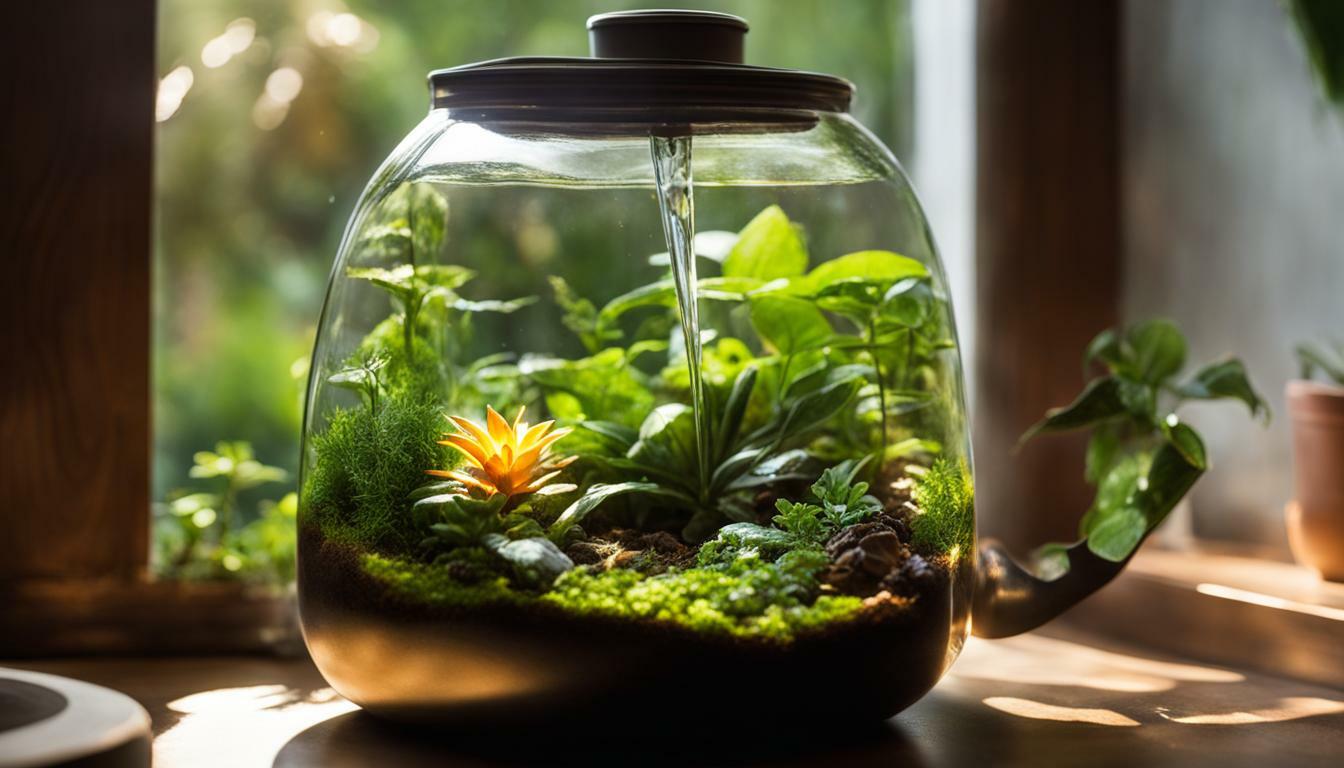Terrariums are a popular choice for indoor gardening, and proper care is essential for their success. Glass containers, in particular, require specific attention to ensure the well-being of the plants within. When creating a terrarium, it’s important to choose a suitable glass container with a wide opening for easy access. The plants should be tropical and small enough to fit in the container without touching the sides. Additionally, the terrarium should have layers such as a drainage layer, soil, hardscape elements, and plants. Maintaining the terrarium involves monitoring humidity levels, proper watering, adequate lighting, and addressing common issues such as mold and overgrown plants. Keeping the glass container clean is also important for clear visibility and overall attractiveness.
- Choose a glass container with a wide opening for easy access to your terrarium.
- Use tropical plants that fit the container without touching the sides.
- Include layers such as a drainage layer, soil, hardscape elements, and plants in your terrarium setup.
- Monitor humidity levels and establish a proper watering routine for your terrarium.
- Ensure adequate lighting for the growth and health of your terrarium plants.
Choosing the Right Glass Container for Your Terrarium
When creating a terrarium, it’s crucial to choose a glass container that meets the specific requirements of the plants and provides easy access for maintenance. The right container will not only enhance the visual appeal of your terrarium but also ensure optimal growth and longevity of your plants. Here are some key factors to consider when selecting a glass container for your terrarium:
Container Size and Shape
Firstly, consider the size and shape of the glass container. A terrarium with a wide opening allows for easy access and maintenance. It also provides ample space for the plants to grow and thrive. Additionally, choose a container that is tall enough to accommodate the desired plants without restricting their vertical growth.
Construction and Material
The construction and material of the glass container are important for creating a suitable environment for your terrarium. Opt for containers made of clear, high-quality glass to allow sufficient light penetration. Avoid containers with tinted or colored glass, as it can limit the amount of light reaching the plants. Furthermore, ensure that the container is well-constructed and doesn’t have any leaks or cracks that could affect the moisture levels within the terrarium.
Drainage and Ventilation
Adequate drainage and ventilation are crucial for maintaining the health of your terrarium. Look for containers that have a drainage hole or provide space for a layer of rocks at the bottom. This allows excess water to drain, preventing root rot and waterlogging. Additionally, choose a container with a removable or adjustable lid, as it allows for proper airflow and prevents the build-up of excessive humidity.
By considering these factors when choosing a glass container for your terrarium, you can create a suitable and visually appealing home for your plants. Remember to check the specific care requirements of your chosen plants to ensure that the container meets their needs. With the right container, your terrarium will flourish and become a beautiful indoor garden.
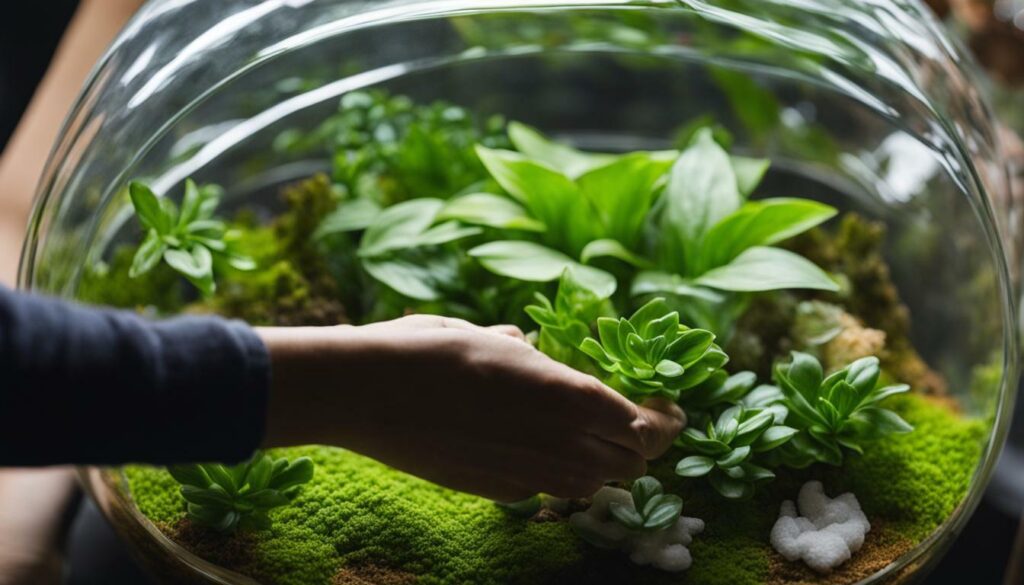
| Container Size and Shape | Construction and Material | Drainage and Ventilation |
|---|---|---|
| Choose a container with a wide opening for easy access and maintenance. | Opt for clear, high-quality glass containers to allow sufficient light penetration. | Look for containers with drainage holes or space for a layer of rocks at the bottom to prevent waterlogging. |
| Ensure that the container is tall enough to accommodate the desired plants without restricting their growth. | Avoid containers with tinted or colored glass, as it can limit light penetration. | Choose containers with removable or adjustable lids for proper airflow and humidity control. |
Terrarium Plant Selection and Placement
The choice of plants plays a significant role in the success of your terrarium, and proper placement is essential for their growth and overall appeal. When selecting plants for your terrarium, opt for tropical varieties that thrive in humid environments. Examples include ferns, mosses, small succulents, and air plants.
Consider the size of the plants and ensure they are small enough to fit comfortably within the container without touching the sides. This allows room for growth and prevents overcrowding. Additionally, choose plants with similar light and water requirements to ensure harmonious growth within your terrarium.
When it comes to placement, create a visually pleasing arrangement by varying the heights, colors, and textures of your plants. Use taller plants as focal points in the background and shorter ones in the foreground. Intersperse different varieties to create a lush and natural-looking terrarium. Play around with different arrangements until you achieve the desired aesthetic appeal.
To complete your terrarium, consider adding a layer of moss on top of the soil. Moss not only adds a decorative touch but also helps retain moisture within the terrarium. It acts as a natural filter, absorbing excess water and releasing it back into the environment when needed.
Table – Recommended Terrarium Plants
| Plant Variety | Light Requirements | Watering Needs |
|---|---|---|
| Ferns | Indirect or filtered light | Moderate, avoid overwatering |
| Mosses | Low to medium light | Moderate, keep slightly damp |
| Succulents | Bright, direct light | Infrequent, allow soil to dry between watering |
| Air plants | Bright, indirect light | Mist or soak once a week |
Remember to research the specific care requirements of each plant before adding them to your terrarium. Some plants may require additional considerations, such as temperature or humidity levels, to thrive.
“The beauty of a well-designed terrarium lies in the thoughtful selection and placement of plants. By creating an environment that mimics their natural habitat, you can enjoy a mini indoor garden that brings a touch of nature into your home.”
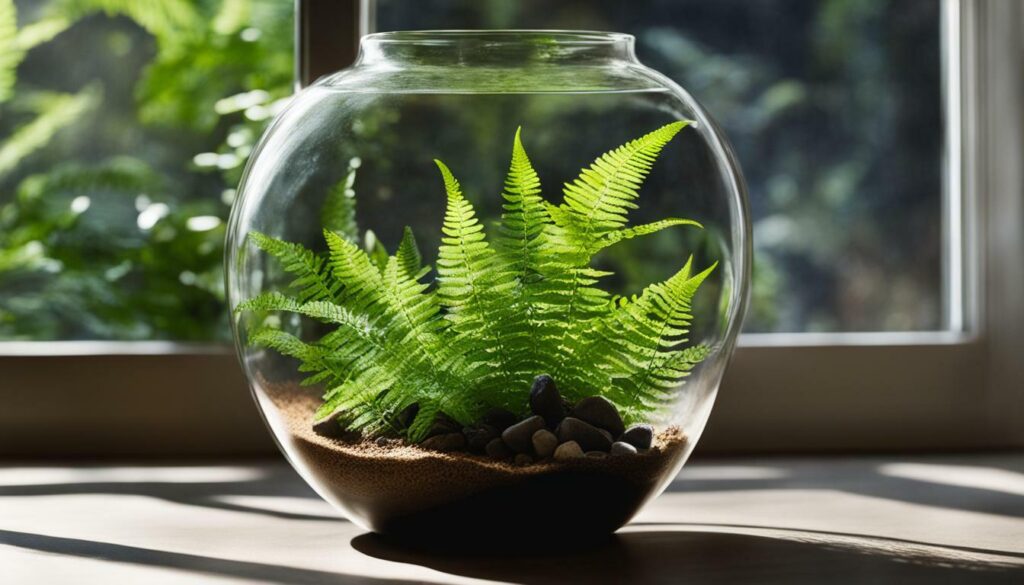
Layers and Components for Terrarium Maintenance
To ensure the health of your terrarium, it’s important to establish a proper foundation with layers and components that aid in its maintenance and longevity. By implementing these essential elements, you can create an environment that promotes the well-being and growth of your terrarium plants.
A terrarium consists of several layers, each serving a specific purpose. Starting from the bottom, the drainage layer is crucial for preventing waterlogging and ensuring proper water flow. This layer can be created using small pebbles or activated charcoal, which help to absorb excess moisture and prevent the roots from becoming waterlogged.
A layer of appropriate soil is essential for providing the necessary nutrients to the plants. You can use a specialized terrarium soil or a mix of potting soil, sand, and perlite for proper aeration and drainage. This layer will support root growth and contribute to the overall health of your plants.
Incorporating hardscape elements such as rocks, driftwood, or decorative items not only adds visual appeal but also enhances the natural feel of your terrarium. These elements serve as focal points and provide additional surfaces for plants to grow on, creating a dynamic and engaging environment.
Finally, carefully select and arrange your terrarium plants. Choose small tropical plants that can thrive in the limited space of the container. Avoid overcrowding by ensuring proper spacing between plants, allowing air circulation and preventing disease. Finish off your terrarium with a layer of moss to add a touch of greenery and aesthetic charm.
| Layers and Components | Purpose |
|---|---|
| Drainage Layer | Prevents waterlogging and ensures proper water flow |
| Soil Layer | Provides nutrients and supports root growth |
| Hardscape Elements | Adds visual appeal and additional surfaces for plants |
| Terrarium Plants | Small tropical plants that thrive in limited space |
| Moss Layer | Adds aesthetic charm and finishing touch |
By establishing these layers and incorporating the right components into your terrarium, you can create an environment that supports the long-term success of your plants. Remember to regularly monitor and adjust the humidity levels, provide adequate lighting, and maintain cleanliness to ensure a thriving and visually appealing terrarium.
Creating a terrarium is like crafting a miniature world within a glass container. The layers and components you choose play a vital role in maintaining the overall health and beauty of this miniature ecosystem.
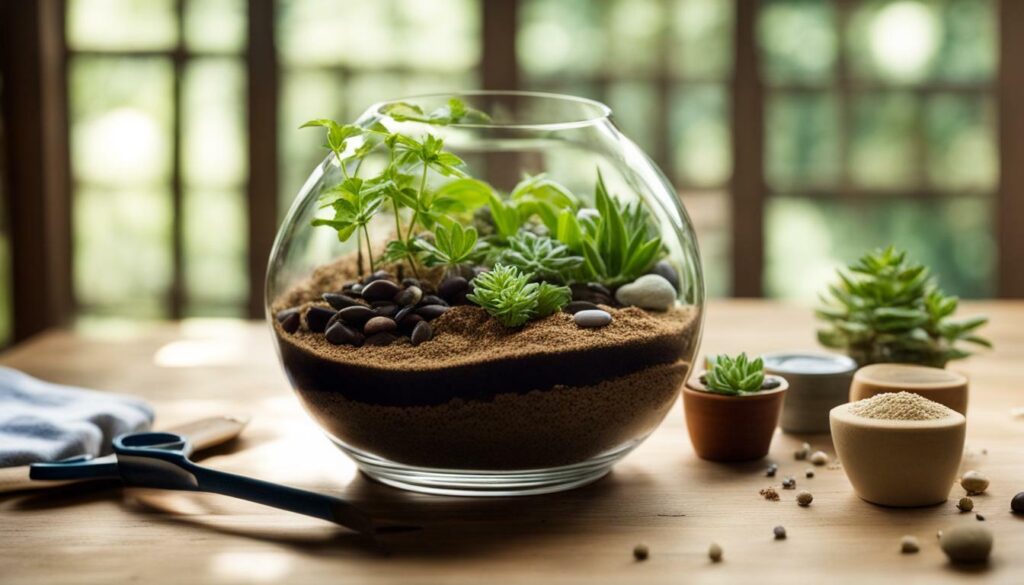
- Start by creating a drainage layer using small pebbles or activated charcoal.
- Add a layer of appropriate soil to provide essential nutrients to your plants.
- Incorporate hardscape elements like rocks or driftwood to enhance the aesthetics of your terrarium.
- Select and arrange small tropical plants, ensuring proper spacing for optimal growth.
- Finish off with a layer of moss for added charm.
Follow these steps, and you’ll establish a solid foundation for maintaining your terrarium and enjoying its beauty for years to come.
Monitoring Humidity Levels and Watering
Proper humidity levels and watering are crucial factors in maintaining the health and vitality of your terrarium plants. Terrariums create a microclimate for your plants, simulating a humid environment that is ideal for their growth. It’s important to monitor the humidity levels within your terrarium to ensure that they remain at an optimal range.
One way to monitor humidity is by using a hygrometer, a device that measures the moisture content in the air. Aim for a humidity level between 50% and 70% for most terrarium plants. If the humidity is too low, you can increase it by misting the plants with water or placing a small dish of water in the terrarium. On the other hand, if the humidity is too high, you can open the lid or remove the covering for a while to allow excess moisture to escape.
When it comes to watering your terrarium, it’s important to strike a balance between providing enough moisture for the plants without causing waterlogging. Overwatering can lead to root rot and the growth of mold or fungus. The frequency of watering depends on factors such as the size of your terrarium, the type of plants, and the moisture level in the soil.
Before watering, check the moisture level of the soil by inserting your finger about an inch deep into the soil. If it feels moist, hold off on watering. If it feels dry, it’s time to water. Use a spray bottle or a small watering can with a narrow spout to water the plants gently, avoiding excessive water on the leaves or hardscape elements. Ensure that the water reaches the root zone without over-saturating the soil.
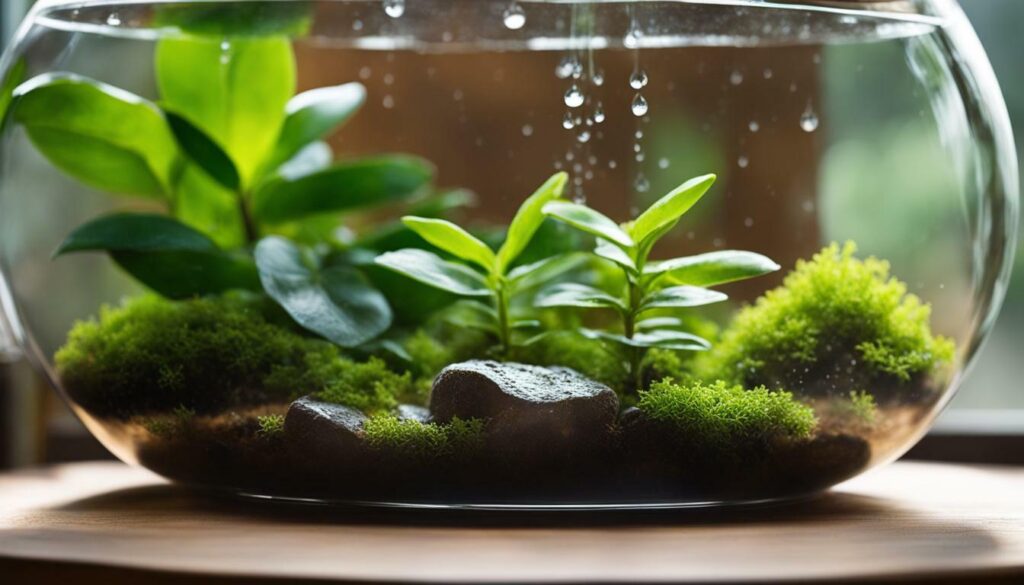
| Signs of underwatering | Signs of overwatering |
|---|---|
|
|
Ensuring Adequate Lighting for Your Terrarium
Providing adequate lighting is essential in promoting photosynthesis and ensuring the overall well-being of your terrarium plants. Just like outdoor plants, indoor terrarium plants need sufficient light to produce energy for growth and development. Without proper lighting, your terrarium plants may become weak and have stunted growth.
When choosing lighting for your terrarium, it’s important to consider the natural light available in the space where the terrarium is located. Placing the terrarium near a window that receives bright, indirect light is ideal. If natural light is limited, you can supplement it with artificial lighting options such as fluorescent or LED grow lights.
When setting up the lighting for your terrarium, ensure that the light source is positioned at the appropriate distance from the plants. Different plants have different light requirements, so it’s essential to research the specific needs of the plants in your terrarium. Keep in mind that too much light can cause heat stress and damage the plants, while too little light can lead to weak, leggy growth.
Regularly monitor the lighting conditions in your terrarium to ensure that the plants are receiving the right amount of light. Observe the growth and appearance of the plants – if they are stretching or leaning towards the light source, it may be an indication that they are not getting enough light. On the other hand, if the leaves are turning yellow or developing brown spots, it could be a sign of excessive light exposure.
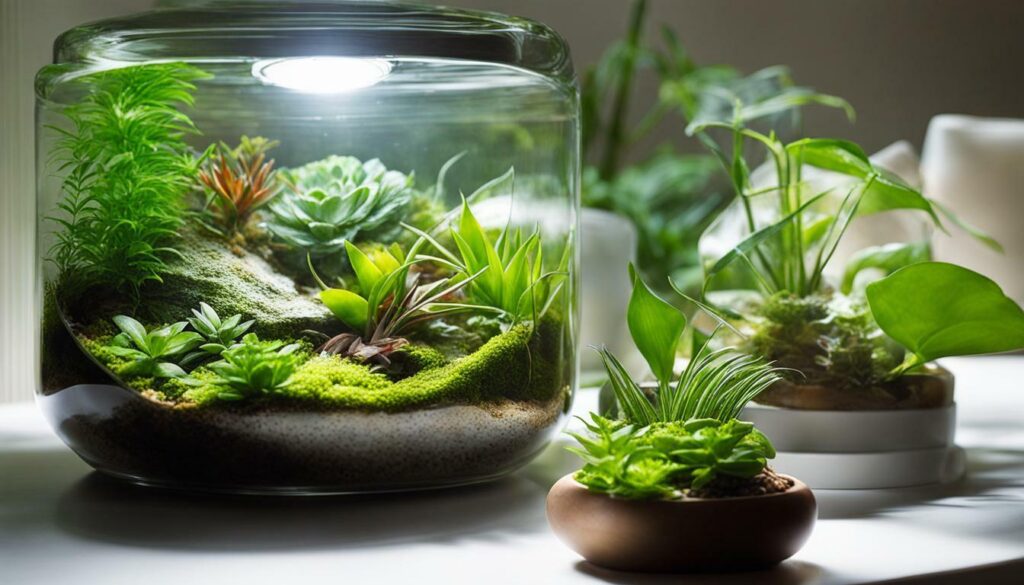
| Lighting Type | Usage |
|---|---|
| Fluorescent grow lights | Provide balanced light spectrum for general terrarium care |
| LED grow lights | Energy-efficient option with customizable light spectrum for specific plant needs |
| Incandescent lights | Avoid using as they generate excessive heat |
Remember to adjust the lighting duration based on the needs of your terrarium plants. Some plants may require longer periods of light exposure, while others may thrive with shorter durations. Experiment with different lighting schedules until you find the optimal balance for your plants’ growth.
Watch Out for Mold and Remove Rotting Plants
Mold growth and rotting plants can pose a threat to the health and longevity of your terrarium, and it’s essential to address these issues promptly. Mold can quickly spread and damage the plants and the overall balance of the terrarium ecosystem. To prevent mold growth, ensure that the terrarium is not overwatered and has proper ventilation. If you spot any signs of mold, such as fuzzy patches or a musty smell, take immediate action to remove it.
Start by removing any affected plants and disposing of them outside the terrarium. This will prevent the mold from spreading to other plants. Use a clean cloth or paper towel to gently wipe away any visible mold on the glass walls or hardscape elements. For stubborn mold, mix a solution of equal parts water and vinegar and carefully scrub the affected areas. Rinse with water and wipe dry.
After addressing the mold issue, it’s crucial to identify and remove any rotting plants. Rotting plants can release harmful gases and introduce bacteria into the terrarium environment. Check for any plants with wilting leaves, mushy stems, or a foul odor. Carefully remove these plants, including their roots, to prevent further contamination. Dispose of them outside the terrarium and replace them with healthy plants.
Regularly inspecting your terrarium for mold and rotting plants is an integral part of its maintenance routine. By addressing these issues promptly, you can ensure the health and vitality of your terrarium for years to come.
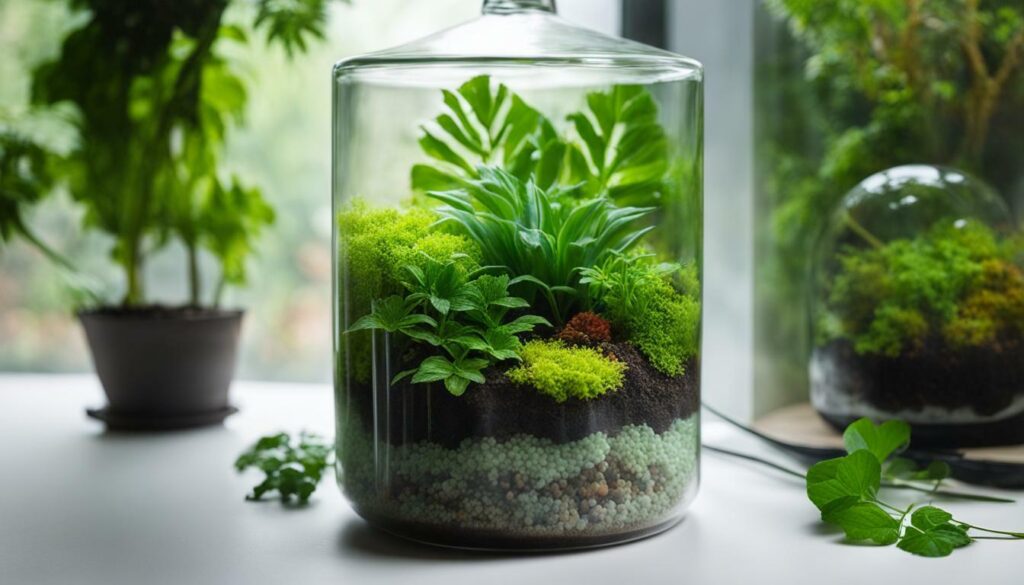
| Preventing Mold and Removing Rotting Plants: |
|---|
| 1. Avoid overwatering and ensure proper ventilation to prevent mold growth. |
| 2. Remove affected plants and dispose of them outside the terrarium. |
| 3. Gently wipe away visible mold on the glass or hardscape elements using a clean cloth or paper towel. |
| 4. For stubborn mold, mix equal parts water and vinegar, and scrub the affected areas. |
| 5. Rinse with water and wipe dry after cleaning. |
| 6. Identify and remove any rotting plants, including their roots, to prevent further contamination. |
| 7. Regularly inspect the terrarium for mold and rotting plants to maintain its health and vitality. |
Trimming Overgrown Plants for Optimal Growth
Regularly trimming overgrown plants is crucial to maintaining a balanced and aesthetically pleasing terrarium while promoting optimal growth. As plants thrive and flourish within the confines of a glass container, they can quickly outgrow their allocated space. In order to prevent overcrowding, it is essential to monitor their growth and intervene with timely trimming.
When it comes to trimming overgrown plants in a terrarium, precision is key. Use sharp, sterilized scissors or pruning shears to carefully snip off the excess foliage or branches. Start by removing any dead or yellowing leaves to maintain the overall health of the plant. Be cautious not to cut too close to the stem, as this can cause damage and potential infection.
Trimming also allows for proper light distribution within the terrarium, ensuring all plants receive equal access to sunlight. By removing excessive foliage, you can prevent shading and enable photosynthesis to occur more efficiently. This promotes healthy growth and prevents weaker plants from being overshadowed by their more robust neighbors.
Remember to remove any trimmed plant material from the terrarium promptly, as decaying leaves or branches can create a breeding ground for mold and other harmful organisms. Keeping a clean and tidy terrarium will contribute to the overall health and beauty of your indoor garden.
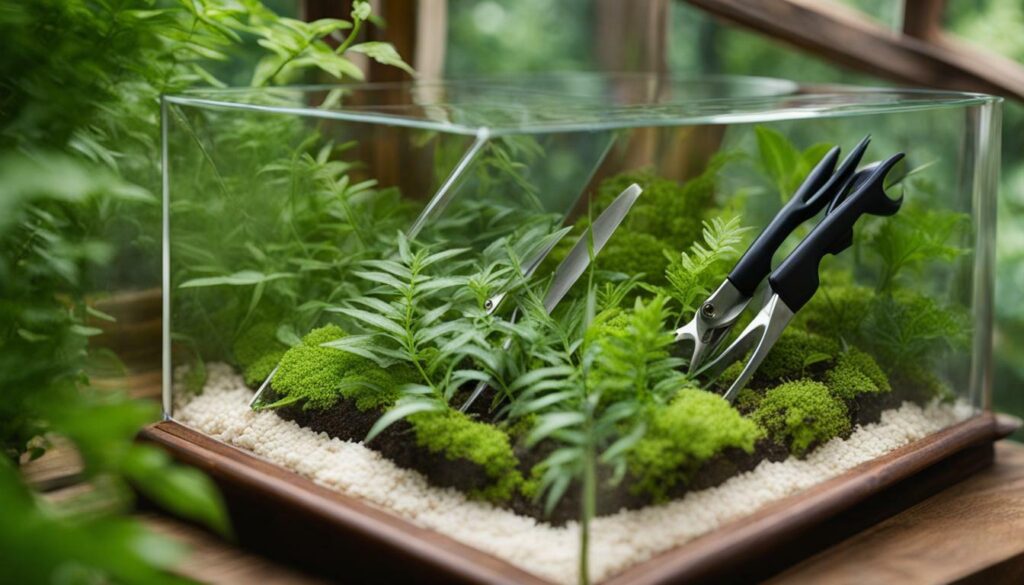
| Tip | Description |
|---|---|
| Use sharp, sterilized tools | Ensure clean cuts and reduce the risk of infection |
| Start with dead or yellowing leaves | Remove any signs of unhealthy growth |
| Trim with precision | Avoid cutting too close to the stem to prevent damage |
| Promote equal light distribution | Remove excess foliage to prevent shading |
| Remove trimmed material promptly | Prevent mold and keep the terrarium clean |
How Can I Prevent Stains on My Terrarium Glass Containers?
To maintain a pristine appearance and prolong the lifespan of your terrarium glass containers, preventing glass stains in terrariums is crucial. Avoid placing them in direct sunlight to minimize the risk of discoloration. Regularly wiping the glass with a mild solution of vinegar and water will help remove any residue and prevent stubborn stains. Additionally, refrain from using harsh chemicals or abrasive materials that can damage the glass surface.
Keeping Your Glass Terrarium Clean
Keeping your glass terrarium clean not only enhances its visual appeal but also contributes to the health and well-being of the plants within. Regular cleaning helps prevent the buildup of dirt, dust, and potential pests that can hinder plant growth. Follow these simple steps to maintain a pristine and thriving terrarium:
- Remove debris: Start by gently removing any fallen leaves, twigs, or other plant debris from the terrarium. Use a small brush or tweezers to carefully lift and remove the unwanted elements without disturbing the plants or disturbing the layers beneath.
- Clean the glass: To clean the glass of your terrarium, mix equal parts white vinegar and water in a spray bottle. Spray the mixture onto the interior surface of the glass and wipe it clean with a soft, lint-free cloth. Avoid using harsh chemicals or abrasive materials that could scratch or damage the glass.
- Prune and trim: Over time, certain plants in your terrarium may outgrow their allotted space. To maintain a balanced and aesthetically pleasing arrangement, regularly trim back any overgrown foliage. Use sharp, clean scissors or pruning shears to carefully remove excess growth, making sure not to damage the surrounding plants.
Remember to always wash your hands thoroughly before and after handling your terrarium to prevent the transfer of dirt, oils, or harmful substances to your delicate plants. With these simple maintenance practices, your glass terrarium will remain a beautiful and healthy home for your plants to thrive in.
| Benefits of a Clean Terrarium |
|---|
| Enhances visual appeal |
| Prevents buildup of dirt, dust, and pests |
| Maintains healthy plant growth |
| Allows for clear visibility and enjoyment |
| Creates a favorable environment for plants to flourish |
“A clean terrarium is a happy terrarium, providing an ideal environment for your beloved plants to thrive and grow.”
Regular cleaning and maintenance are essential to ensure the longevity and vitality of your glass terrarium. By providing a clean and well-cared-for environment, you can enjoy the beauty of your indoor garden while promoting the health and well-being of your plant collection.
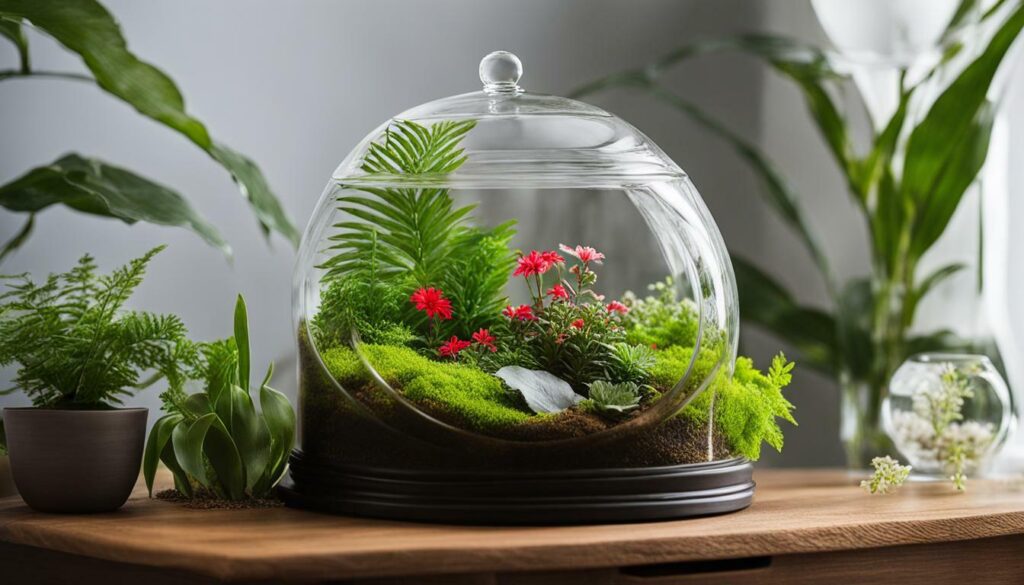
Proper terrarium care and glass container maintenance are essential for the long-term success of your indoor garden. Terrariums, the beautiful glass containers that hold plants, can be a delightful addition to any space. Whether you create a terrarium for decoration, scientific observation, or plant propagation, taking care of it is crucial to ensure the health and longevity of your plants.
When making a terrarium, choosing the right glass container is key. Look for one with a wide opening that allows easy access for maintenance. The size should be suitable for the plants you choose, and the construction should be sturdy to support the weight of the soil and hardscape elements.
It’s important to select the appropriate plants for your terrarium and arrange them thoughtfully. Tropical plants are best suited for these enclosed environments, and they should be small enough to fit comfortably without touching the sides of the container. Creating layers with a drainage layer at the bottom, followed by soil and hardscape elements, will provide the ideal foundation for your plants to thrive.
To maintain your terrarium’s health, monitor humidity levels and establish a watering routine that keeps the moisture balance just right. Adequate lighting is crucial for your plants’ growth and development, so consider the types of lighting sources that will provide the necessary exposure. Additionally, be vigilant about mold growth and promptly remove any rotting plants to preserve the overall health of the terrarium.
Regular plant maintenance, including trimming overgrown plants, will promote optimal growth and prevent overcrowding. And don’t forget to keep your glass container clean for clear visibility and overall attractiveness. By following these guidelines, you can master the basics of terrarium care and enjoy the beauty of your indoor garden for years to come.
FAQ
What is a terrarium?
A terrarium is an indoor gardening container made of glass that holds plants. It can be created for decoration, scientific observation, or plant propagation.
How do I choose the right glass container for my terrarium?
When choosing a glass container for your terrarium, look for one with a wide opening for easy access. The container should be suitable in size and construction for optimal plant growth.
What kind of plants should I use in my terrarium?
Tropical plants that are small enough to fit in the container without touching the sides are ideal for terrariums. Choose plants that thrive in humid environments.
What layers and components are necessary for terrarium maintenance?
To maintain your terrarium, you’ll need a drainage layer at the bottom, followed by a layer of soil, hardscape elements like rocks or driftwood, and the plants themselves. Moss can be added as a finishing touch.
How do I monitor humidity levels and watering for my terrarium?
It’s important to check humidity levels regularly and establish an appropriate watering routine to maintain the right moisture balance for your plants’ well-being.
What kind of lighting should I use for my terrarium?
Proper lighting is essential for the growth and development of your terrarium plants. Consider using types of lighting sources that provide adequate exposure for optimal health.
How do I prevent mold growth and remove rotting plants in my terrarium?
To prevent mold growth, ensure proper ventilation and avoid overwatering. If you notice any rotting plants, remove them promptly to maintain a healthy environment.
How do I trim overgrown plants in my terrarium?
Regular plant maintenance is important for a healthy terrarium. Trim overgrown plants to promote optimal growth and prevent overcrowding.
How do I clean a glass terrarium?
Keeping your glass terrarium clean is crucial for clear visibility and overall attractiveness. Use appropriate cleaning methods and products to maintain a pristine appearance.

